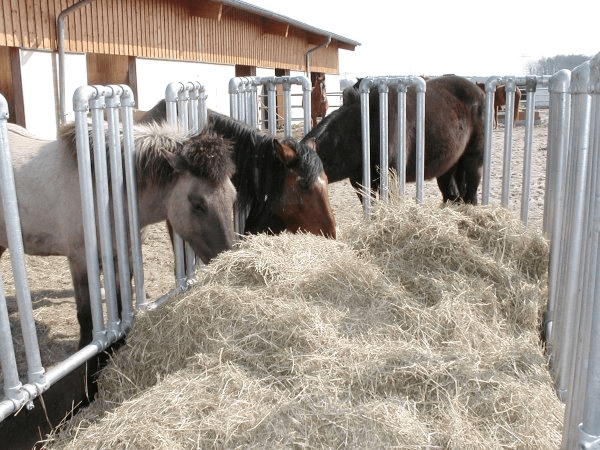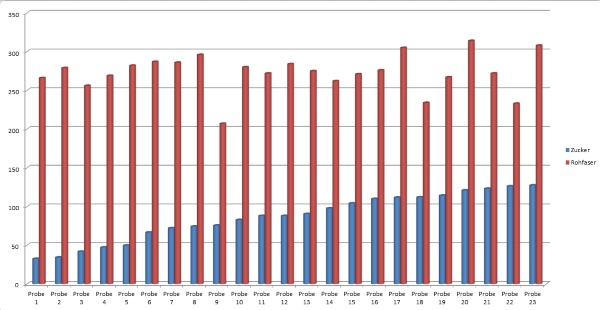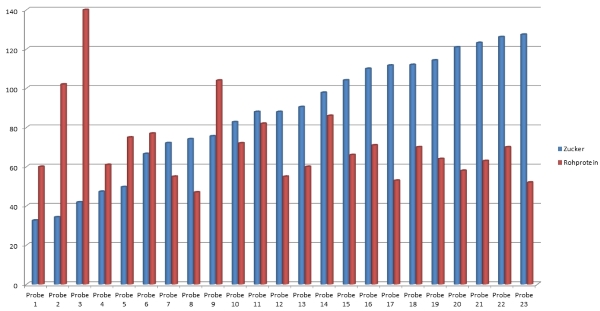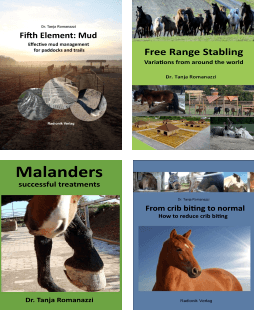The significance of sugar content in hay
In my view, the sugar content in hay has a very strong influence on a horse’s condition (degree of obesity) and overall health. Which is why I am always surprised and concerned to see that many experts do not take it into account at all.

A great number of studies and feed calculations (even the more recent ones) simply state “hay, end of bloom” and then insert an average value. A recognised feeding expert recently informed me that there was no need to consider the sugar content. The crude fibre content was, apparently, far more important. This allows one to determine the time hay was harvested and, as a stable owner, you only need to remember to specify a later harvesting time for lower-energy hay. This creates a higher crude fibre content and a lower sugar content.
But in my experience, the connection isn’t that simple. The following chart shows all the hay samples (23) that we sent for lab testing over the last 2 years. The blue columns show the sugar content graded according to size (from 32.6g to 127.4g) and the red columns represent the crude fibre content (from 207g to 314g) (all values based on 1 kg of feed). I find it difficult to see an obvious connection here.

Another error I have observed frequently is equating low-sugar with low-protein. You’ll often hear it said, that there “isn’t much left in there.” Which apparently makes it unsuitable for sport horses and ideal for “hardy” horses. But again, this point is a lot more nuanced than that.
Hay that is harvested very late has a higher crude fibre content and a lower sugar and protein content compared with hay harvested from the same meadow at an earlier date. That is one connection.
But another observation is that grasses with a high sugar content also have a low protein content (you can’t have a consistently large amount of everything all the time) and, conversely, low sugar grasses often have a higher protein content.
The following chart shows the sugar content of our hay samples represented by the blue columns and the raw protein content represented by the red columns.

Clearly, it is possible to have two types of hay with the same energy values; one of them with a very high sugar content and a low protein content, and the other exactly the other way round.
In my opinion, all horses benefit from low sugar hay, while care should be taken to ensure that sport horses and breeding horses are fed a sufficiently high protein content.
What are the causes?
The principal objective of grass cultivation over the last 20 years has been the development of high sugar grasses (HSG). The sugar content of the popular ryegrass and fescue grasses is significantly higher than most horses’ tolerance levels (I also have my doubts as to whether these are healthy for cattle). Hardiness is another breeding goal. Grasses are bred to survive and thrive under unfavourable conditions.
Which means that ryegrass and fescue grasses are in strong evidence on most meadows. In the last few years, following the brouhaha about fructan (complex sugars suspected of causing laminitis), there have been many low fructan grass seed mixtures on offer. But as closer look at these shows, in many cases this simply involves decreasing the amount of ryegrass seeds. But the ryegrass is still added to the mixture. Accordingly, meadows are initially sown with 15% ryegrass and 85% more or less low sugar grass types. But if you look at the meadows three years later, the proportion of ryegrass has grown significantly, due to its marked robustness (and presumably due to the soil quality and type of fertilization).
Effects on equine health
High sugar consumption has similarly negative effects on horses as it does on humans. It can lead up to a building up of unhealthy fatty deposits, put extra strain on the pancreas, cause a variety of metabolic disorders and according to recent studies, there is a strong possibility of a connection to the high increase in cases of laminitis. (An experiment demonstrated that laminitis can be caused by too much insulin on its own, without any additional bowel activity).
From observing horses in our own free range stable, I have come to the conclusion, and several readers have confirmed this, that horses behave differently if they are fed really low sugar hay. The horses take feeding breaks of their own accord, without appearing to be hungry. On the contrary, they seem a lot more relaxed and content. (The same effect can be observed in humans after cutting out sugar completely for 4 weeks).
My own conclusion
It is worth having the sugar content in your hay tested. Frequently, one’s own estimates turn out to be significantly off the mark. And any measure that ensures your horses are fed low sugar hay is worth the effort. Any extra costs these might entail are frequently set off by savings in vet bills.

